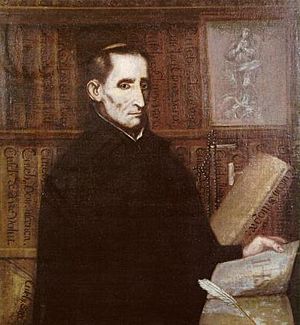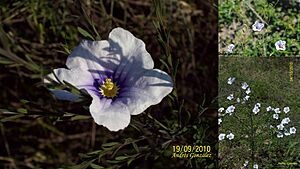Juan Eusebio Nieremberg facts for kids
Juan Eusebio Nieremberg y Ottín (born 1595 – died 7 April 1658) was a Spanish Jesuit priest and a deep thinker about spiritual life, known as a mystic.
Nieremberg was born and died in Madrid, Spain. His parents were from Germany. He studied classic subjects at the Royal Court and science at Alcalá. He also studied canon law, which is church law, at Salamanca.
In 1614, he joined the Society of Jesus, also known as the Jesuits. This is a religious group within the Catholic Church. He later became a teacher of scripture (religious texts) at the Jesuit school in Madrid. He taught there until he passed away.
He was highly respected for his writings about faith. His books, De la afición y amor de Jesus (1630) and De la afición y amor de María (1630), were very popular. They were translated into many languages, including Arabic, Dutch, French, German, Italian, and Latin.
While some of his works are not widely read today, his version (1656) of the book Imitation is still well-liked. His book De la hermosura de Dios y su amabilidad (1649) is also important. It is seen as one of the last great works of mysticism in Spanish literature.
His Writings
Juan Eusebio Nieremberg wrote many books during his lifetime. His works covered a wide range of topics. He wrote about spiritual growth, nature, and the lives of important religious figures.
Some of his notable books include:
- Obras y Días (1628): This book was a guide for leaders and princes. It talked about how to live a good and virtuous life.
- Curiosa Filosofía y cuestiones naturales (1630): This work explored interesting questions about nature and philosophy.
- Historia naturae, maxime peregrinae (1634): This book was about the history of nature, especially focusing on unusual or foreign plants and animals.
- De la diferencia entre lo temporal y lo eterno (1640): This book discussed the difference between things that last only for a short time and things that last forever.
- Vidas ejemplares y venerables memorias de algunos claros varones de la Compañía de Jesús (1647): This work shared inspiring stories and memories of important men from the Jesuit order.
His writings helped many people understand their faith better. They also showed his deep knowledge of both spiritual and natural subjects.
A Plant Named After Him
Two Spanish botanists, Ruiz and Pavón, honored Juan Eusebio Nieremberg. They named a beautiful plant in the tobacco family after him. This plant is called Nierembergia. They described it in their book Flora Peruvianae, et Chilensis Prodromus in 1794. This shows how respected he was, even in the world of science.
Images for kids
See also
 In Spanish: Juan Eusebio Nieremberg para niños
In Spanish: Juan Eusebio Nieremberg para niños





